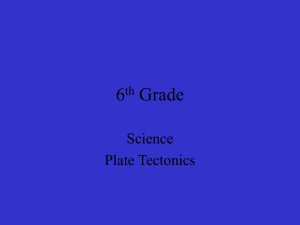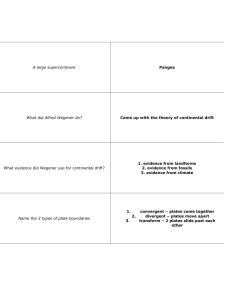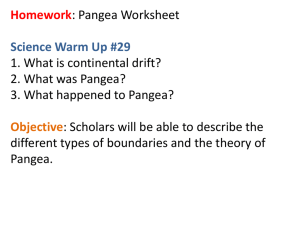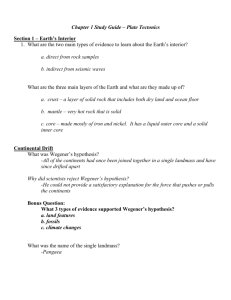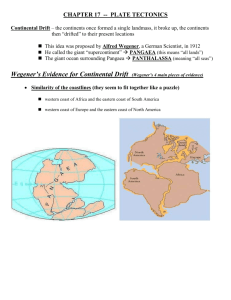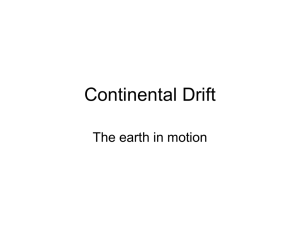Chapter 4 - Plate Tectonics
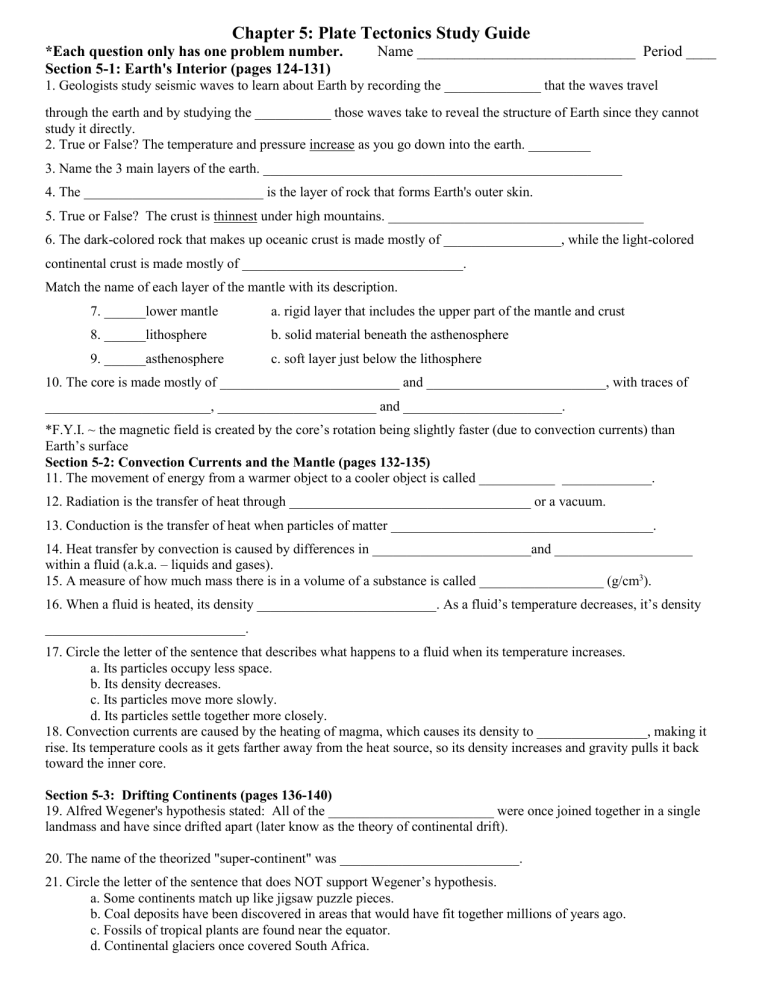
Chapter 5: Plate Tectonics Study Guide
*Each question only has one problem number. Name _____________________________ Period ____
Section 5-1: Earth's Interior (pages 124-131)
1. Geologists study seismic waves to learn about Earth by recording the ______________ that the waves travel through the earth and by studying the ___________ those waves take to reveal the structure of Earth since they cannot study it directly.
2. True or False? The temperature and pressure increase as you go down into the earth. _________
3. Name the 3 main layers of the earth. ____________________________________________________
4. The __________________________ is the layer of rock that forms Earth's outer skin.
5. True or False? The crust is thinnest under high mountains. _____________________________________
6. The dark-colored rock that makes up oceanic crust is made mostly of _________________, while the light-colored continental crust is made mostly of ________________________________.
Match the name of each layer of the mantle with its description.
7. ______lower mantle a. rigid layer that includes the upper part of the mantle and crust
8. ______lithosphere
9. ______asthenosphere b. solid material beneath the asthenosphere c. soft layer just below the lithosphere
10. The core is made mostly of __________________________ and __________________________, with traces of
________________________, _______________________ and _______________________.
*F.Y.I. ~ the magnetic field is created by the core’s rotation being slightly faster (due to convection currents) than
Earth’s surface
Section 5-2: Convection Currents and the Mantle (pages 132-135)
11. The movement of energy from a warmer object to a cooler object is called ___________ _____________.
12. Radiation is the transfer of heat through ___________________________________ or a vacuum.
13. Conduction is the transfer of heat when particles of matter ______________________________________.
14. Heat transfer by convection is caused by differences in _______________________and ____________________ within a fluid (a.k.a. – liquids and gases).
15. A measure of how much mass there is in a volume of a substance is called __________________ (g/cm 3 ).
16. When a fluid is heated, its density __________________________. As a fluid’s temperature decreases, it’s density
_____________________________.
17. Circle the letter of the sentence that describes what happens to a fluid when its temperature increases. a. Its particles occupy less space. b. Its density decreases. c. Its particles move more slowly. d. Its particles settle together more closely.
18. Convection currents are caused by the heating of magma, which causes its density to ________________, making it rise. Its temperature cools as it gets farther away from the heat source, so its density increases and gravity pulls it back toward the inner core.
Section 5-3: Drifting Continents (pages 136-140)
19. Alfred Wegener's hypothesis stated: All of the ________________________ were once joined together in a single landmass and have since drifted apart (later know as the theory of continental drift).
20. The name of the theorized "super-continent" was __________________________.
21. Circle the letter of the sentence that does NOT support Wegener’s hypothesis. a. Some continents match up like jigsaw puzzle pieces. b. Coal deposits have been discovered in areas that would have fit together millions of years ago. c. Fossils of tropical plants are found near the equator. d. Continental glaciers once covered South Africa.
22. How do the locations of mountains support Wegener’s idea about how mountains form?
_________________________________________________________________________________________
Section 5-4: Sea-Floor Spreading (pages 141-147)
23. The ________ - _________________ ridge is the longest chain of mountains in the world.
24. Circle the letters that are true about mid-ocean ridges. a. The mid-ocean ridges were mapped using sonar. b. The mid-ocean ridges are found only below the Pacific Ocean. c. The mid-ocean ridges are completely under water. d. The tops of some mid-ocean ridges are split by a steep sided valley.
25. A device that bounces sound waves off underwater objects is called __________________________.
26. The process that continually adds new material to the ocean floor is called __________ - ______________
_______________________________.
27. Where does new crust come from? _________________________________________________________
28. List 3 types of evidence for sea-floor spreading: ____________________________________________
_____________________________________ and _________________________________________
29. Circle the letter of each sentence that is true about Earth’s magnetism. a. At times in the past, a compass needle on Earth would have pointed south. b. Rock that makes up the ocean floor lies in a pattern of magnetized stripes. c. The pattern of stripes is different on both sides of the mid-ocean ridges. d. The magnetic memory of rock on the ocean floor changes over time.
30. Long, narrow and very deep canyons where the ocean floor bends down toward the mantle are called ___________ -
_______________ __________________.
31. _________________________ is the process by which the ocean floor sinks beneath a deep-ocean trench.
32. The Pacific Ocean is shrinking because its trenches are swallowing the ocean floor faster than the ridges can produce more ocean floor. However, the Atlantic Ocean expanding because:
_____________________________________________________________________________________
Section 5-5: The Theory of Plate Tectonics (pages 150-154)
33. The lithosphere is broken into separate sections called __________________________.
34. True or False? Plates can carry continents, parts of the ocean floor, or both. ________________________
35. What is a scientific theory? ______________________________________________________________
________________________________________________________________________________________
36. State the theory of plate tectonics. _________________________________________________________
________________________________________________________________________________________
37. A __________________ _________________ is a deep valley that forms where two plates pull apart.
38. A _______________ _____________________ is a line where different pieces of the lithosphere meet.
39. A ______________________________________ is a break in Earth's crust where rocks have slipped past each other.
40. The 3 types of plate boundaries are __________________________, __________________________ and
__________________________.
41. How fast do tectonic plates move? ________________________________________________________
42. True or False? The pieces of the super-continent Pangea began to drift apart about 225 million years ago.
______________________________
